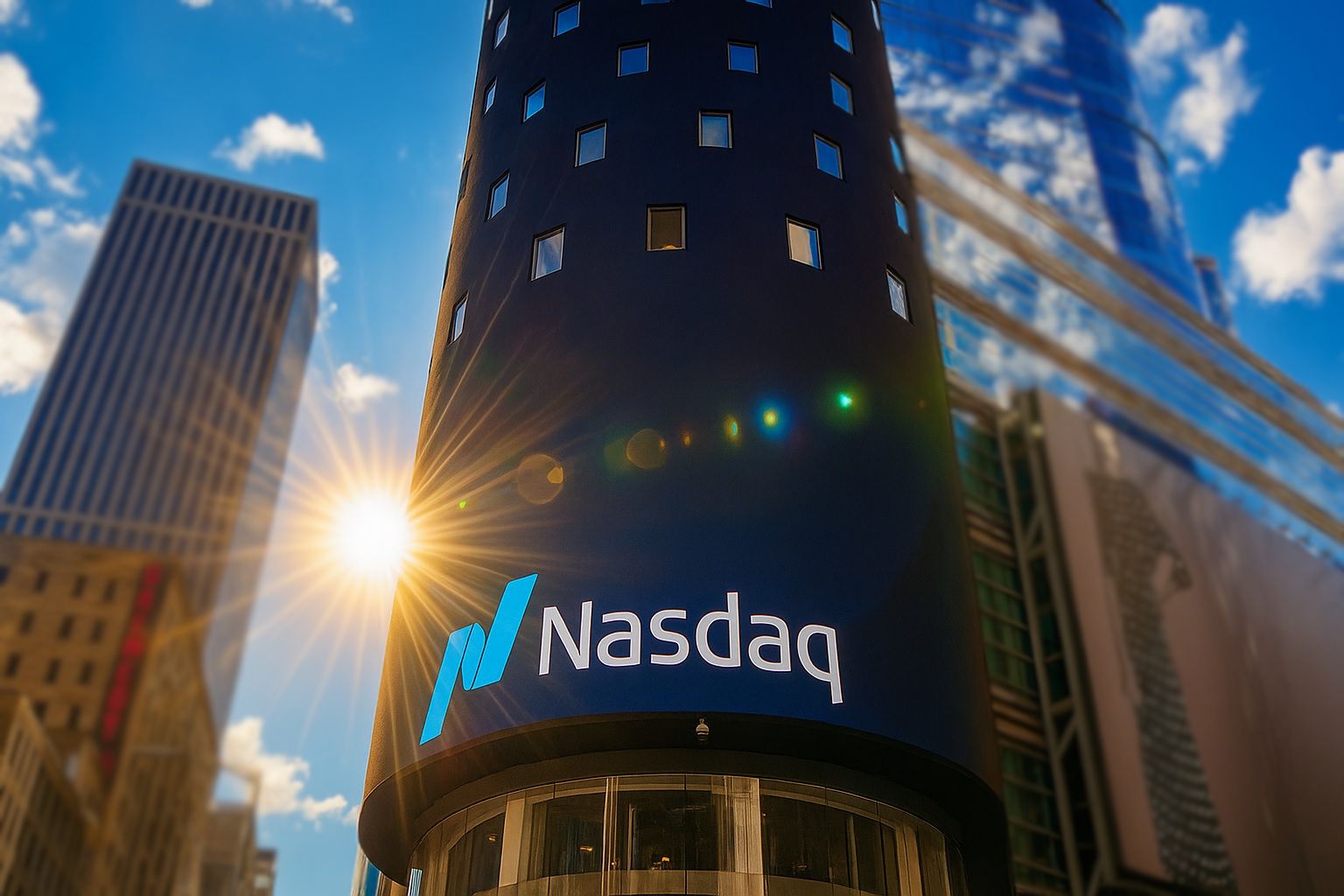After one of its sharpest reversals of the year on Thursday, the Nasdaq Composite is trading choppily on Friday, November 21, 2025, as Wall Street tries to balance renewed Federal Reserve rate-cut hopes with lingering AI-bubble and crypto-crash fears.
By late morning in New York, the Nasdaq Composite was fluctuating around 22,100–22,200, modestly above Thursday’s close near 22,078, after earlier trading roughly 0.2%–0.6% higher on the day. [1] The moves come a day after the tech-heavy benchmark slumped 2.2%, notching its lowest close since September 11 and helping to put U.S. equities on track for their worst week since April. [2]
Key takeaways on the Nasdaq today
- Nasdaq Composite today is trading just above 22,000 after Thursday’s 2.2% plunge, swinging between small gains and losses. [3]
- A December Fed rate cut is back in play: market odds have surged from around 39% to more than 70% after dovish comments from New York Fed President John Williams. [4]
- AI and chip stocks remain under pressure despite strong Nvidia earnings, with November seeing a steep pullback in high-valuation tech names. [5]
- Bitcoin’s crash to a six‑month low near $86,000 is weighing on crypto-exposed Nasdaq names and related ETFs. [6]
- Month-to-date, the Nasdaq is down roughly 7%, part of a wider tech-led selloff that has also dragged the S&P 500 toward its worst November since 2008. [7]
Where the Nasdaq stands today
Real-time data around late morning showed the Nasdaq Composite (IXIC) trading close to 22,200, up about 0.5% intraday, with an intraday range roughly between 21,900 and 22,250. [8] Shorty after the open, Reuters data put the index up about 0.24% at 22,131, alongside modest gains in the Dow and S&P 500, as early buyers stepped back into beaten-down tech. [9]
That intraday bounce follows a brutal Thursday session in which:
- The Nasdaq Composite fell 2.2%, or 486 points, to 22,078.05.
- It marked the lowest close since September 11, erasing a big early-day rally.
- The Cboe Volatility Index (VIX) jumped more than 11% to above 26, signaling heightened fear.
- Declining issues outnumbered advancers on the Nasdaq by more than 3 to 1. [10]
November overall has turned into a painful month for growth investors. One analysis estimates the Nasdaq is down about 7% month-to-date, while the S&P 500 has dropped around 4.4%, putting the broad market on track for its worst November since the 2008 crisis and its weakest week since April. [11]
Rate-cut hopes: why the Fed suddenly matters even more
Ironically, part of the reason the Nasdaq is so volatile this week is that traders are obsessing over the next Federal Reserve move as much as they are over AI earnings.
On Thursday, a long-delayed U.S. jobs report for September showed nonfarm payrolls rising by 119,000, more than double consensus expectations of 50,000, while the unemployment rate ticked up to 4.4%, a four‑year high. [12] The stronger‑than‑expected hiring initially slashed market odds of a December Fed rate cut to below 40%, stoking fears that rates might stay higher for longer — a negative for richly valued tech. [13]
That narrative flipped again on Friday morning:
- New York Fed President John Williams said there is still “room” to cut rates in the near term without undermining the central bank’s inflation goals. [14]
- According to CME FedWatch data cited by multiple outlets, odds of a December 25-basis-point cut jumped from roughly 39% to more than 70%, with one estimate at 73.3%. [15]
That dovish tilt helped:
- Push the Nasdaq, S&P 500 and Dow modestly higher in early trade, with the Nasdaq up about 0.24% near 22,131 around 09:49 a.m. ET. [16]
- Lift spirits in growth and megacap names that were hammered on Thursday.
At the same time, Fed communication remains mixed. Boston Fed President Susan Collins argued that policy is currently “in the right place,” signaling skepticism about the need for another cut this year — one reason volatility has stayed elevated. [17]
AI and chip stocks: the core of the Nasdaq’s pain
The Nasdaq Composite is heavily concentrated in technology, with about 63% of its weight in tech stocks and most of the rest in consumer discretionary and communication services. [18] As of September 30, 2025, the top 10 components included:
- Nvidia (NVDA)
- Microsoft (MSFT)
- Apple (AAPL)
- Amazon (AMZN)
- Meta Platforms (META)
- Broadcom (AVGO)
- Tesla (TSLA)
- Alphabet (GOOGL/GOOG)
- Netflix (NFLX) [19]
That concentration has been a gift on the way up — the index’s official fact sheet shows a year‑to‑date price return of 17.34% as of September 30 — but it has amplified the damage as AI-bubble fears take center stage this month. [20]
Thursday’s rout
On Thursday:
- AI bellwether Nvidia swung from a big early gain after strong earnings guidance to close down 3.2%. [21]
- Other AI‑linked names like Oracle and Microsoft tumbled, with Oracle down about 6.6% and Microsoft off 1.6% on the day. [22]
- A global wave of selling hit semiconductor stocks, from TSMC and ASML in Asia and Europe to U.S. chipmakers, as investors reassessed whether the AI trade has run too far, too fast. [23]
One analysis notes that Nvidia has fallen about 11% so far in November, even after blockbuster results and guidance, while remaining up more than 30% for the year and still towering above a $5 trillion market cap earlier this month. [24]
Friday’s stabilisation — but not full relief
On Friday morning, the picture is more mixed:
- Alphabet is among the brighter spots, with Reuters citing a gain of around 4% in early trade. [25]
- Real-time quotes show Apple trading about 1.5% higher, while Amazon is modestly positive.
- Nvidia and Tesla, however, remain slightly lower on the day, reflecting ongoing unease about AI valuations and electric‑vehicle demand. [26]
The result: the Nasdaq Composite today is trying to rebound, but with its AI and chip heavyweights still under pressure, any recovery remains tentative.
Crypto crash adds another headwind
The risk-off mood isn’t just about AI stocks. Bitcoin and the broader crypto market have been hit hard this week, and that matters for the Nasdaq because of:
- Crypto-adjacent companies (exchanges, miners, chipmakers) listed on the index.
- ETFs and ETPs tied to Bitcoin and Ethereum that trade on Nasdaq.
A widely cited report from TechBuzz notes that Bitcoin plunged to about $86,325, its lowest level since April 21, after a surprisingly strong U.S. jobs report slashed earlier expectations for aggressive Fed easing. [27] The article highlights:
- A broad selloff across major altcoins like XRP and Ethereum.
- Renewed focus on how Fed policy and macro data can overwhelm crypto‑specific narratives. [28]
On Friday, crypto-linked products were among the most active names in Nasdaq pre‑market trading:
- The iShares Bitcoin Trust ETF (IBIT) and iShares Ethereum Trust ETF (ETHA) both saw heavy volumes as investors reacted to the latest leg down in digital assets. [29]
- Leveraged and tech-focused ETFs like TQQQ and QQQ also ranked high on the volume list, underscoring how traders are using derivatives to express short‑term views on the Nasdaq 100. [30]
With crypto and AI often treated as part of the same “high-octane tech trade”, the simultaneous stress in both areas is amplifying volatility in the Nasdaq index complex. [31]
Nasdaq 100: technical picture still cautious
While the Nasdaq Composite is the broad barometer, many institutional investors track or trade the Nasdaq 100 (NDX) — the 100 largest non‑financial companies listed on Nasdaq.
Technical strategists note that:
- The Nasdaq 100 remains below key resistance around 23,000–23,100, an area that roughly corresponds to Wednesday’s lows and important moving averages.
- Trading below those levels is seen as “decidedly bearish” in the short term, keeping sentiment fragile even as futures and intraday prices bounce. [32]
In other words, Friday’s bounce so far looks more like a relief rally than a decisive trend change.
Stock-specific stories shaping the Nasdaq narrative
Beyond the macro themes, individual company stories are also influencing how investors think about the Nasdaq’s future:
- Walmart’s exchange switch: Retail giant Walmart announced it will move its primary stock listing from the NYSE to the Nasdaq Global Select Market, with trading expected to begin there on December 9, 2025 under the same ticker WMT. TechStock²
- The move — billed as the largest exchange transfer ever by market value — reinforces Nasdaq’s branding as a “tech-powered” marketplace and raises the prospect of Walmart eventually joining the Nasdaq‑100, which could draw additional passive and ETF flows into the index over time. TechStock²+1
- Smaller Nasdaq standouts: On the more speculative side, stocks like Epsium Enterprise (EPSM), a Macau-based drinks distributor listed on Nasdaq, have seen extreme price swings this week, including a reported 66% surge on Thursday and more volatility on Friday — a reminder that the exchange still hosts plenty of high‑beta, story‑driven names. TechStock²
While these idiosyncratic moves don’t drive the overall index in the way mega‑caps do, they color sentiment around the “risk-taking culture” synonymous with the Nasdaq brand.
How the Nasdaq Composite is built — and why that matters now
To understand why the Nasdaq index has been so sensitive to AI and rate headlines, it helps to look at its construction:
- The Nasdaq Composite tracks over 3,300 securities listed exclusively (or primarily) on the Nasdaq Stock Market.
- Eligible constituents include common stocks, ADRs, tracking stocks and limited partnership interests, but exclude ETFs, preferreds, rights and most derivatives. [33]
- As of September 30, 2025, the index was:
- 63.4% Technology
- 17.2% Consumer Discretionary
- With smaller allocations to communication services, health care, financials and other sectors. [34]
- The top 10 holdings alone account for a very large share of the index’s market cap, dominated by AI and cloud platforms such as Nvidia, Microsoft, Apple, Amazon, Meta, Tesla and Alphabet. [35]
Earlier this year, that structure helped the Nasdaq Composite rally strongly, with official data showing a 17.34% price return for 2025 year‑to‑date as of September 30. [36] But it also means that:
- When AI valuations are questioned, or
- When Fed expectations whipsaw, or
- When crypto and other high‑beta trades unwind,
the Nasdaq Index can move dramatically even if more defensive sectors are holding up.
What to watch next for the Nasdaq Index
For traders and longer-term investors alike, several themes will likely determine whether the Nasdaq’s current pullback turns into a deeper correction or a buyable dip:
- Federal Reserve meeting in December
- If odds of a December rate cut stay above ~70% and the Fed delivers, that could support higher valuations for growth stocks. [37]
- Any renewed hawkish surprises — especially after the delayed jobs data — risk another bout of turbulence.
- AI earnings and guidance
- Investors are demanding proof that massive AI spending will translate into sustainable profits, not just headline‑grabbing capex. [38]
- Names like Nvidia, Broadcom, Microsoft and Alphabet will remain the primary swing factors for the Nasdaq 100 and, by extension, the broader Nasdaq Composite.
- Crypto and risk appetite
- If Bitcoin’s drop to six‑month lows stabilises and crypto ETP flows calm down, some pressure could come off high-growth tech that has been trading in tandem with digital assets. [39]
- Technical levels on the Nasdaq 100
- A sustained move back above resistance near 23,000–23,100 would signal improving risk appetite.
- Remaining below those levels keeps the short-term trend cautious to bearish. [40]
Bottom line
The Nasdaq Index today sits at the crossroads of AI optimism, rate-cut speculation and crypto fatigue. After Thursday’s 2.2% plunge to its lowest close since September, Friday’s choppy rebound — buoyed by renewed hopes for a December Fed cut and modest gains in Apple, Alphabet and other mega‑caps — shows that buyers aren’t ready to abandon tech altogether. [41]
But with AI valuations under scrutiny, Bitcoin near multi‑month lows, and the Nasdaq 100 still below key resistance, the path ahead for the Nasdaq Composite is likely to remain volatile into year‑end.
This article is for information and analysis only and should not be taken as investment advice. Always consider your own financial situation or consult a licensed professional before making trading decisions.
References
1. www.tradingview.com, 2. www.nasdaq.com, 3. www.tradingview.com, 4. seekingalpha.com, 5. www.nasdaq.com, 6. www.techbuzz.ai, 7. www.livemint.com, 8. www.investing.com, 9. www.tradingview.com, 10. www.nasdaq.com, 11. www.livemint.com, 12. www.nasdaq.com, 13. www.livemint.com, 14. www.tradingview.com, 15. seekingalpha.com, 16. www.tradingview.com, 17. www.tradingview.com, 18. indexes.nasdaqomx.com, 19. indexes.nasdaqomx.com, 20. indexes.nasdaqomx.com, 21. www.nasdaq.com, 22. www.nasdaq.com, 23. business.times-online.com, 24. www.livemint.com, 25. www.tradingview.com, 26. www.investing.com, 27. www.techbuzz.ai, 28. www.techbuzz.ai, 29. www.nasdaq.com, 30. www.nasdaq.com, 31. www.techbuzz.ai, 32. www.forex.com, 33. indexes.nasdaqomx.com, 34. indexes.nasdaqomx.com, 35. indexes.nasdaqomx.com, 36. indexes.nasdaqomx.com, 37. seekingalpha.com, 38. www.nasdaq.com, 39. www.techbuzz.ai, 40. www.forex.com, 41. www.nasdaq.com







